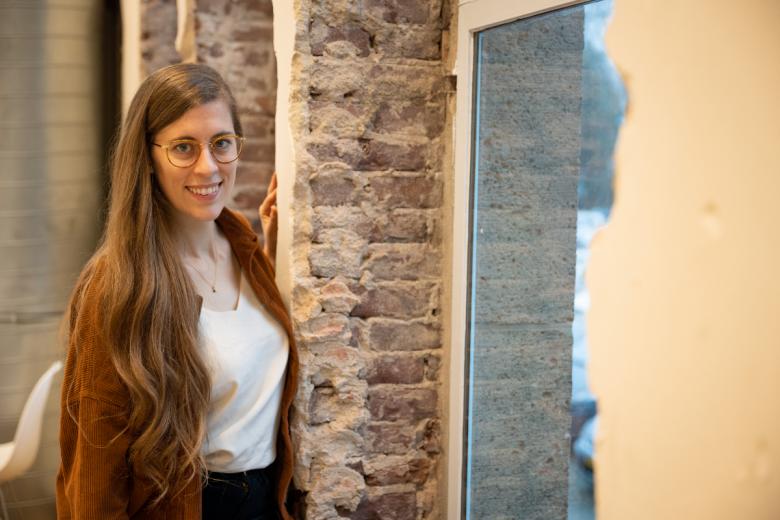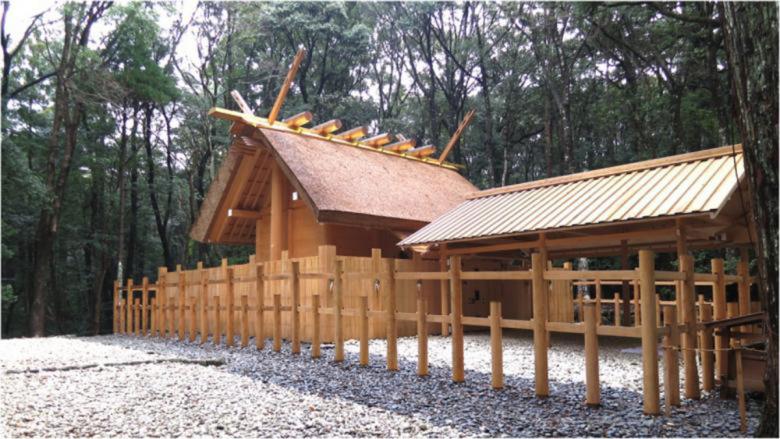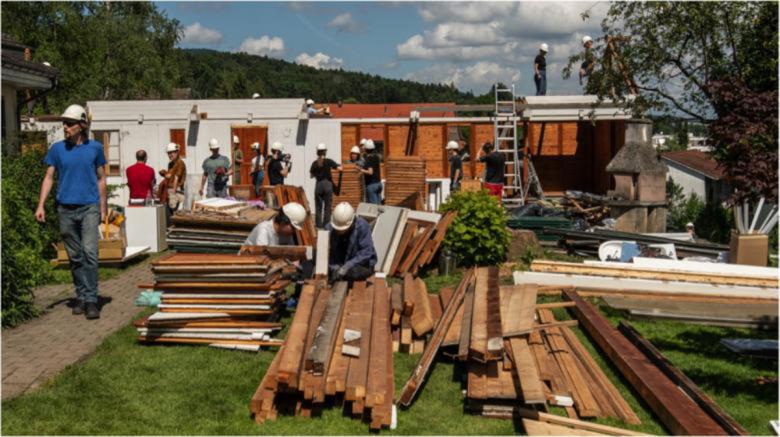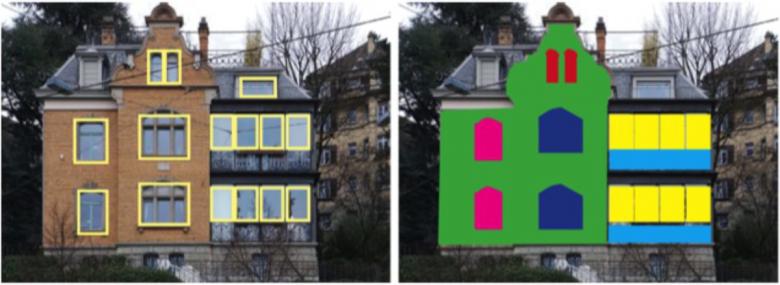Circular Building the Easy Way
Susanna Koeberle
8. February 2023
Catherine De Wolf conducts research in transdisciplinary digital circular construction and teaches at ETH Zurich. (Photo: Paul Barendregt)
Catherine De Wolf has been Assistant Professor and Director of the Chair of Circular Engineering for Architecture at the Department of Civil, Environmental and Geomatic Engineering at ETH Zurich since September 2021. She spoke with us about the challenges of circular construction.
Mrs. De Wolf, you work in very different fields. You teach, research, build, and produce films — and that's just the short version of your work. Do you think this form of transdisciplinarity will also become the norm in architecture?I studied architecture and engineering at the same time and have always thought of these disciplines as working together. Today, I notice that in many areas we are moving more and more toward multi-, cross-, inter- and transdisciplinarity. Actually, this concept has existed for a long time: an example is the master builders during the Renaissance. But the increase in knowledge also brought specialization. That's not bad per se, because it has moved science forward.
However, to meet today's environmental challenges, we need to reconnect the disciplines. We can't address the massive environmental impact of the construction industry with architecture alone. Although I have specialized in certain domains, I am also active in other disciplines where I work with specialists. This form of transdisciplinary work is very important for me, especially with regard to the problems I am trying to solve.
This question brings us back to your first one. I like to learn from history and the past. Even in ancient Rome, people built in a circular fashion and the reuse of materials was common sense. Raw materials were expensive because they were not available to the same extent as they are today, since they were sourced mostly locally and without the extensive use of fossil fuels and machinery as we know today. The system of extraction, production, and disposal in its extreme form emerged about 100 years ago, when land prices also rose. People began to tear down old buildings to build new, larger ones. In my research, I try to learn not only from nature but also from history. Because certain ways of thinking fell into oblivion.
Indeed! For example, we talk about the built environment and refer to what man has created, while nature is in constant interaction with us. Another problem is that we have many habits in our everyday lives that we don't even think about, such as throwing away plastic. Before these products existed — which wasn't that long ago — people went shopping with their containers. On top of that, the throwaway mentality is a cultural and sociological problem. Fortunately, that's changing now. My students are calling on us professors to go even further.
Learning from other cultures: the famous Ise Shrine in Japan (Photo: Guy Nordenson)
Can you give us a concrete example from practice?We dismantled a building on the ETH campus, the material of which was to be disposed of afterwards. It was the students who urged to keep the components. Without their pressure, this would not have been possible. The young generation holds us accountable for our actions.
I just talked about how the past inspires me. We've been aware of the ecological challenges since the 1980s, but we've too done little. In the last ten years, we have seen great technological advances in the digital realm, and I think we need to make better use of them. We can't ask people to turn back time and build the way they used to. But we can use the new technologies to make the circular economy faster and easier.
An example from my research: Thanks to Google Street View, we have access to data on all the façades. Algorithms can recognize materials and pass on related information directly to us. The potential I see here is huge. Or I wonder how robots could be used in dangerous demolition maneuvers. We are at an early stage with applying all these technologies toward a circular economy; at the moment, these applications are mostly visions for a more regenerative future. That's why I'm doing research.
Exactly, a kind of matchmaking or "Tinder for Reuse". I am currently developing this together with reuse protagonists from Switzerland and abroad.
A bandstand was dismantled together with students. At their urging, the components were not simply disposed of. (Photo © ETH Zurich, Chair of Circular Engineering for Architecture)
You already hinted at the answer earlier: Do you think that a young generation of architects with new values is growing up at the universities? Or does the notion of the genius who produces architectural icons still prevail?It is our job to show students a path in architecture that is valuable to society. I have been teaching for almost ten years now, and I often heard from students that this was their first course in life cycle analysis or circular building. Given the role of the construction industry in the climate crisis, I found it odd that this course was optional. I believe these courses should be mandatory! However, we currently do not have enough professors in this field. The growing demand is coming from the students, and that gives me confidence. I also observe a much more critical and demanding attitude among graduates towards their future work. That was not the case when I was a student.
People often ask me what the best materials are. But you have to choose building materials depending on the desired function and their availability; concrete can also compare favorably. Personally, I often work with wood in my projects with students. It is a naturally renewable material when forests are managed sustainably, it sequesters carbon, and it is very light and easy to work with. It's also ideal for building something with my students in a short time. My partner, with whom I founded the company Anku, knows a lot about wood. We believe that wood also has a positive influence on people's psyche. Wood joints, when designed properly, are easy to disassemble. Nevertheless, I am not saying that wood is better per se than other materials. The key thing about reusing materials is the way they are joined. For example, for metal, I prefer bolted connections rather than welded connections.
Artificial intelligence recognizes certain patterns in Google Street View images and can generate information on this basis. (Visualization © ETH Zurich, Chair of Circular Engineering for Architecture)
Your film "Genius Loci" is about local materials and historical processing techniques. What role do these themes play in your work?The film shows the second field I'm working on besides research on digital technologies. Anku is more about low-tech and historical craftsmanship. We have forgotten many techniques that work very well, such as Japanese wood joints or certain ways of finishing the surface of wood. When building our yurts, that's exactly the kind of old techniques we use.
With this film, we wanted to show how architecture and crafts can be used to reconnect with nature and other cultures. On February 23, Julia Watson will be speaking in my course. She wrote the book Lo-TEK: Design by Radical Indigenism, which also addresses these issues. On my travels I have come across such techniques myself: for example, bridges made of grass in Peru. That was one of the topics of my doctoral thesis.
That's right. A good example is Martin Rauch's rammed earth buildings. In Switzerland, this is luxury architecture, since craftsmanship is expensive in our latitudes. In other countries it's the other way around, but people there often don't want to build that way because this type of construction is sometimes associated with poverty. People would rather build in concrete and steel as is done in rich countries.
There are two schools of thought in this regard. Personally, I like to reuse components in such a way that you don't notice it. Sometimes that's how you can convince people. But there are also colleagues or clients who have a different view. They think that the old parts should be clearly recognizable as such. The building should clearly communicate that you want to do something positive. Reuse can also become a signature.
As for the restriction: For me, architecture also has to do with ethics; we can no longer make buildings that just look nice. Architecture can be art, but it also has a social responsibility. If you look at certain new buildings, you get the impression that this aspect is sometimes forgotten. I think we should introduce something like a Hippocratic Oath for architects, like doctors have. Architects should commit themselves to respecting the environment. Also, it's sufficient to come see the results of our students when they design with reused materials to find proof that reusing materials can only stimulate creativity.
Roof of a wooden yurt from the Anku Company, co-founded by Catherine De Wolf (Photo © Catherine De Wolf)
How does Switzerland compare internationally in terms of regulations or, more generally, in terms of awareness of ecological issues?In Europe, generally, a lot of progress has already been made in the field of circular construction. I can speak about France, the Netherlands, or Belgium, where I have worked myself. In the Netherlands, for example, there is a real circular economy policy. In Switzerland, Minergie has been strongly promoted, but unfortunately the issue of grey energy has been ignored for too long. In this country, the cantons would have the power to change things. There is always a good and a bad side to regulations.
But the problem with a building is that no two are alike, and sometimes regulations unfortunately have a negative effect. One would have to assess each case individually. However, my calculations show that renovation is usually more ecological than demolition and new construction of a standard-compliant house in its place; but it takes longer and is more expensive. That's exactly the reason why it is not done, and that's a pity. Architects also bear responsibility for this.
Today, many young people get their information from social media. I once made a post on Instagram with a film about a robot sorting construction waste for subsequent reuse. It had 6,500 views in the first few minutes. As a result, I had exchanges with researchers from MIT and UC Berkeley. Films and images are a global form of communication.
Everything is an economy of scale. That's part of the reason why I do research on artificial intelligence. The goal of my research into digital technologies is to lower the cost of circular construction. If we had a kind of Tinder for reusable materials on our mobile phones, as I mentioned earlier, it would be cheaper to find a door in the neighborhood, for example, than to go to a DIY store and buy one. My goal is to make reuse as inexpensive and easily accessible as possible. During the Corona crisis, when freight traffic was restricted, you could already observe that more components were reused.
Construction of a dome from reused materials together with students inspired by the Anku domes (Photo © ETH Zurich, Nicole Davidson)
You said in an interview that circular construction creates new jobs. Can you explain that?It is indeed the case that craftsmanship know-how is becoming increasingly rare today. Circular construction can help to upgrade craft knowledge. In logistics, too, more workers are needed, and this creates new jobs. Another aspect is that reuse creates local jobs. You can't outsource reuse because it needs people on site. One reason for unemployment is that many things are produced in countries where production is cheaper.
The theme of this year's Engadin Art Talks was hope. What motivates you to keep going? Are you hopeful?
I am a very optimistic person. I like to learn from history, culture, nature and digitalization. Those are my four sources of inspiration that keep me going. It gives me a lot of hope that people are again attaching greater value to nature today. In this context, there is a renewed appreciation for ancient or indigenous techniques.
I believe we are about to move away from the linear pattern I mentioned at the beginning. Digitalization also holds huge potential. I would like to see digital tools being used to do good and not bad. I also observe that the term circular construction is becoming more self-evident; I don't have to explain why it's important as often. When I used this term 15 years ago, people thought circular construction had something to do with round buildings.
German architects Margit Sichrovsky and Kim Le Roux are also committed to building a functioning circular economy in the construction industry: to the interview.





